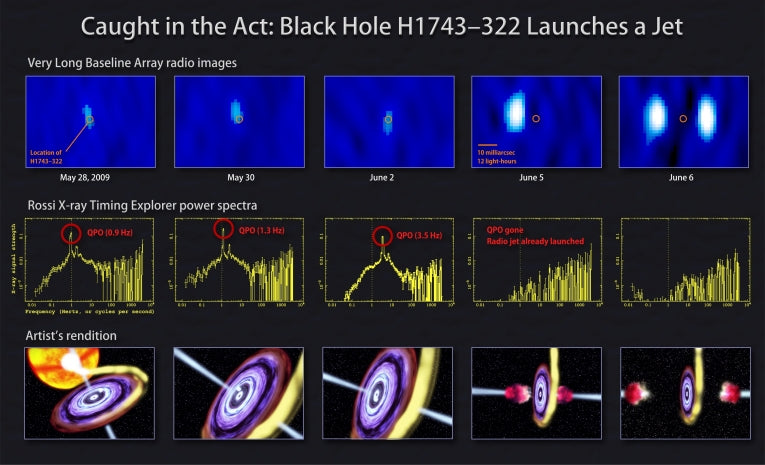The NASA Rossi X-Ray Timing Explorer satellite, which is known as RXTE for short and the NSF's Very Long Baseline Array radio telescope, or VLBA as it is more commonly known, helped a group of astronomers identify the moment when a black hole sent jets of superfast gaseous knots into space in our very own galaxy.
The gases were pumped out at 25% of the speed of light from just outside of the black hole's event horizon. Anything at the event horizon or beyond has no chance of escaping and therefore it could not have been from past this point.
Gregory Sivakoff was the person who announced the findings. He said, "Like a referee at a sports game, we essentially rewound the footage on the bullets progress, pinpointing when they were launched. With the unique capabilities of RXTE and the VLBA, we can associate their ejection with changes that likely signalled the start of the process."
The finding is incredibly exciting has stirred plenty of debate. The research all revolved around a binary system which is simply referred to as H1743-322, a not very elegant name, but functional nevertheless. It stands at over 28 thousand light years away from the Scorpius constellation and was discovered back in 1977. It is known to consist of a normal star as well as a black hole of an unknown size. Matter circles in towards the black hole which causes it to be heated to temperatures in the tens of millions of degrees. When mass gets heated to such temperatures it then emits X-rays and some of the matter gets hurled outwards at unbelievable speeds, in this case at 25% of the speed of light.
This action has all been picked up as X-ray and radio emissions which suddenly stopped. Then, the radio emission increased and a detailed image showed a bullet of gas moving outwards from the system. This was seen a second time. Chris Done who is an astrophysicist at the University of Durham was not involved in any of the research but did have something to say on the matter; "This research provides new clues about the conditions needed to initiate a jet and can guide our thinking about how it happens".
Very little is known about black holes. They are a phenomenon that have plenty of proof pointing towards their existence but as nobody has ever been able to peer into one, it is hard to say what truly happens when matter enters them. They do however seem to suck in literally anything that comes near to them and have even been seen to suck in light itself. Many believe that they could even suck in time and space and when calculations have been done black holes appear to have some extremely strange properties indeed.
The same phenomenon has now been seen in another galaxy where there is a black hole that weights literally millions or possibly even billion times the mass of our sun which makes for a mind-boggling thought. It is believed that this could drive outflows by millions of light-years.
"Black hole jets in binary start systems act as fast-forwarded versions of their galactic-scale cousins, giving us insights into how they work and how their enormous energy output can influence the growth of galaxies and clusters of galaxies." Said James Miller-Jones who is the head of research at Curtin University in Perth, Australia.
The Rossi X-Ray Timing Explorer ran up until January 2012 and first started its job of observation back in December of 1995. It was run and used by NASA. The VLBA is the largest astronomical tool in the entire world and also stands as the highest resolution instrument as well.
It is hoped that these new observations and data can help to increase the understanding that we have of black holes as well as the jets that are given off. In some of the cases, the size, data and speed of everything involved stretches the human imagination are hard to imagine as possible, however, these actions and phenomenon are being observed and recorded and are showing us just how amazing the expanses of space really are.










